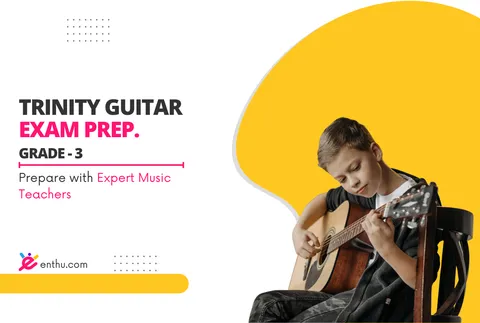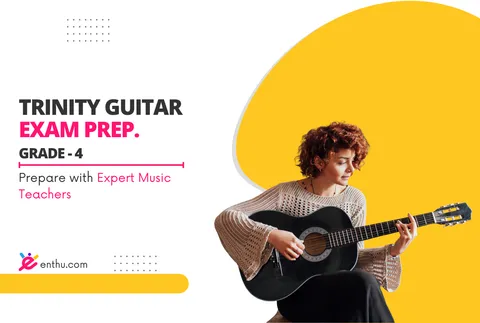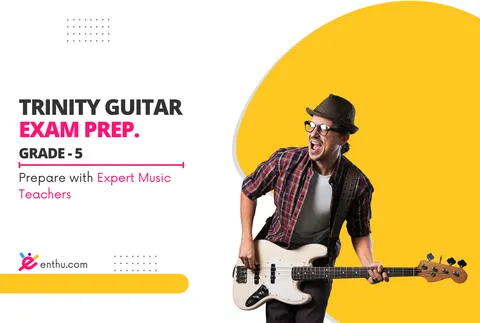Once you’ve mastered the basics and passed your Trinity Guitar Grade 1 and 2 exams, it’s time to step up to the intermediate stage - Grades 3, 4, and 5. This is where your music starts to come alive. You move beyond simple melodies and chords to exploring rhythm, expression, tone, and style.
At this level, learner begin to develop their own sound and confidence. It’s an exciting transition that connects foundational skills to artistic performance. Whether you’re a young learner building toward a music diploma or an adult rediscovering your passion, the Trinity Guitar Intermediate Level is a powerful milestone in your musical growth.
- What does the Trinity Intermediate Level mean?
- Goals for Intermediate Learners
- Grade 3 - Expanding Your Skills
- Grade 4 - Building Musical Identity
- Grade 5 - Confidence and Expression
- How Enthuziastic Helps You Succeed
- Benefits of Completing the Intermediate Level
- Internal Learning Path and Next Steps
- Conclusion
- FAQs
- 1. Who can enroll in the Intermediate Level course?
- 2. How long does it take to complete Grades 3 to 5?
- 3. What styles of music are covered?
- 4. What equipment do I need?
- 5. Can I appear for all three grades in a year?
- 6. Are the exams online or offline?
- 7. How valuable is a Grade 5 certificate?
- 8. How does Enthuziastic support exam preparation?
- 9. Do I need to know music theory?
- 10. How do I enroll for the Intermediate Level Guitar Course?
What does the Trinity Intermediate Level mean?
The Trinity Intermediate Level bridges the gap between basic learning and advanced musical understanding. Grades 3, 4, and 5 focus on:
Expanding your technical skillset
Learning advanced chords, scales, and arpeggios
Improving tone control, hand coordination, and expression
Understanding musical styles and genres
Strengthening theory and sight-reading skills
This is where you start to feel truly connected to your guitar. You don’t just play notes - you express emotions.
Goals for Intermediate Learners
Before diving into each grade, here are the main goals for learners at the intermediate level:
Develop control over sound quality and rhythm.
Learn to perform confidently in front of others.
Improve reading and understanding of music notation.
Build versatility across musical styles - classical, contemporary, and acoustic.
Strengthen finger agility, speed, and endurance.
Prepare for higher-level performance and exam pieces.
Deepen understanding of harmony, scales, and tone.
These goals set the foundation for Grades 6 to 8, where mastery and musical interpretation become the key focus.
Grade 3 - Expanding Your Skills
At Grade 3, learners begin transitioning from simple patterns to structured performances. You’ll explore cross-string playing, basic barre chords, and alternate picking to build smoother coordination.
Common techniques introduced include:
Using rest and free strokes interchangeably
Playing in two octaves
Smooth chord changes (C, G, D, A minor, E minor)
Introduction to simple hammer-ons and pull-offs
Basic sight-reading with rhythm variations
Example pieces often include classical tunes, folk melodies, or simplified versions of popular guitar compositions that balance melody and rhythm.
Practice routine tip: Learners are encouraged to spend 20–30 minutes daily revising scales and 10 minutes focusing on tone control exercises.
Common challenges: Maintaining rhythm consistency and switching chords cleanly. Instructors at Enthuziastic help overcome these through finger-position drills and metronome-based timing practice. Buy Grade 3-5 Book

Image Credit - Trinity College London

Grade 4 - Building Musical Identity
Grade 4 introduces a stronger focus on musical interpretation and expression. You begin to move your hands across different fret positions with confidence and start shaping your tone and phrasing to suit each piece.
Key techniques include:
Smooth position shifting between frets 1–7
Use of dynamics (playing softly and loudly within a single piece)
String bending and controlled vibrato
Advanced rhythmic understanding, including syncopation
Combining melody and accompaniment simultaneously
You might play pieces from styles like Spanish classical, light jazz, or modern acoustic ballads, helping you experiment with musical personality.
Practice routine tip: Spend 40 minutes daily alternating between technical drills and expressive piece-playing. Record your sessions to self-evaluate tone control and accuracy.
Common challenges: Finger fatigue and tone inconsistency. Enthuziastic’s mentors guide you through relaxation techniques and hand exercises to overcome these effortlessly.

Grade 5 - Confidence and Expression
Grade 5 marks a major transition - from playing with guidance to performing with confidence and independence. Students are expected to show maturity in tone, phrasing, and musical storytelling.
Techniques refined at this level:
Playing extended arpeggios and two-octave scales fluently
Applying tone color variations (ponticello and dolce effects)
Using fingerpicking for dynamic control
Managing complex time signatures (3/4, 6/8, 12/8)
Executing tremolo and harmonics for expressive playing
Example pieces often include intermediate classical works by Sor or Carulli, simplified jazz ballads, or fingerstyle versions of popular acoustic songs.
Practice routine tip: Learners usually practice 60–90 minutes daily, dividing time between scales, exam pieces, and mock performances.
Common challenges: Balancing speed with clarity, memorizing long pieces, and controlling performance anxiety. Enthuziastic addresses these through mock recitals and Victory Vibe sessions, where learners perform live to build confidence before their Trinity exam.

How Enthuziastic Helps You Succeed
At Enthuziastic, we make sure every learner feels supported and confident in their journey. Here’s how we help you prepare for your Trinity Guitar Exams:
Live interactive classes: Learn directly from certified instructors in small groups or one-on-one settings.
Flexible schedules: Choose class timings that fit your lifestyle, whether you’re a student or working professional.
Progress tracking: Monitor your learning through our app, with summaries and performance updates after each session.
Personalized feedback: Get regular feedback from mentors to polish your technique and improve faster.
Exam readiness: We guide you through mock exams, registration, and performance tips to ensure you feel confident.
Recording access: Revisit your lessons anytime to strengthen practice at your own pace.
Each of these features ensures that both kids and adults experience structured learning while still enjoying the fun of playing music.
Benefits of Completing the Intermediate Level
Finishing Trinity Guitar Grades 3, 4, and 5 offers long-term benefits, both musically and personally.
Builds stronger hand coordination and rhythm control.
Deepens understanding of music theory and reading.
Boosts confidence to perform publicly.
Prepares you for advanced grades and professional performance.
Enhances focus, patience, and creativity.
Adds global certification to your music portfolio.
For many learners, this is also the point where they start exploring song composition, improvisation, and group performances.
Internal Learning Path and Next Steps
If you’re just starting your Trinity journey, check out our blog on Beginner Level - Grades 1 & 2 to understand how we build the foundation for musical success.
Once you complete this stage, stay tuned for our upcoming guide on Advanced Level - Grades 6 & 7, where we’ll explore expressive mastery and professional performance techniques.
Conclusion
The Trinity Guitar Intermediate Level is where music turns from practice into expression. It’s a journey that shapes your musical identity, develops discipline, and opens doors to advanced learning. Whether you’re preparing for a music career or simply exploring a lifelong passion, these grades lay the perfect foundation for growth.
👉 Book a free trial session and take your next step toward Trinity Guitar success.
FAQs
1. Who can enroll in the Intermediate Level course?
Anyone who has completed Trinity Grade 2 or equivalent guitar basics can join. Both kids and adults are welcome.
2. How long does it take to complete Grades 3 to 5?
Typically, learners complete these grades in 8 to 12 months, depending on practice consistency and instructor guidance.
3. What styles of music are covered?
Trinity’s syllabus includes classical, contemporary, and acoustic styles, giving learners a wide musical perspective.
4. What equipment do I need?
A well-tuned acoustic or classical guitar, a music stand, and a device for online sessions are all you need.
5. Can I appear for all three grades in a year?
Yes, some learners progress quickly and attempt multiple grades within a year, depending on their skill and dedication.
6. Are the exams online or offline?
Trinity offers both online and in-person exam formats. Your Enthuziastic Student Success Manager/ Family Buddy will help you choose and register.
7. How valuable is a Grade 5 certificate?
Trinity Grade 5 certification is globally recognized and adds significant value to college applications or music resumes.
8. How does Enthuziastic support exam preparation?
We provide live lessons, progress tracking, practice schedules, mock exams, and personalized feedback to ensure full readiness.
9. Do I need to know music theory?
Yes, basic theory is important, but don’t worry - it’s taught alongside your practical lessons at this level.





Comments